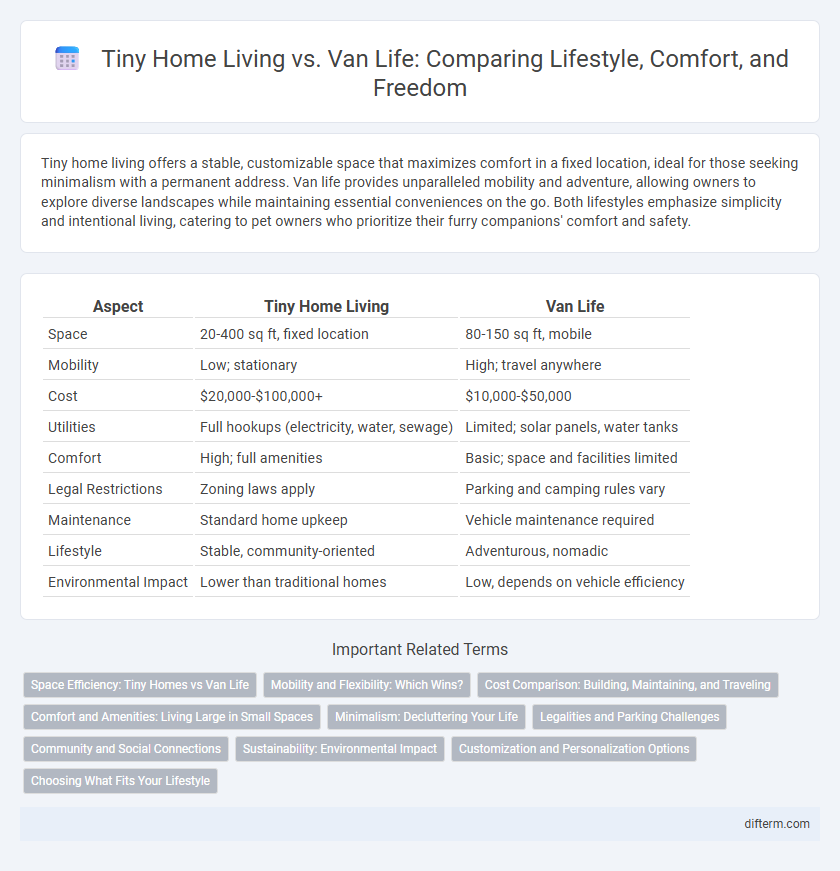Tiny home living offers a stable, customizable space that maximizes comfort in a fixed location, ideal for those seeking minimalism with a permanent address. Van life provides unparalleled mobility and adventure, allowing owners to explore diverse landscapes while maintaining essential conveniences on the go. Both lifestyles emphasize simplicity and intentional living, catering to pet owners who prioritize their furry companions' comfort and safety.
Table of Comparison
| Aspect | Tiny Home Living | Van Life |
|---|---|---|
| Space | 20-400 sq ft, fixed location | 80-150 sq ft, mobile |
| Mobility | Low; stationary | High; travel anywhere |
| Cost | $20,000-$100,000+ | $10,000-$50,000 |
| Utilities | Full hookups (electricity, water, sewage) | Limited; solar panels, water tanks |
| Comfort | High; full amenities | Basic; space and facilities limited |
| Legal Restrictions | Zoning laws apply | Parking and camping rules vary |
| Maintenance | Standard home upkeep | Vehicle maintenance required |
| Lifestyle | Stable, community-oriented | Adventurous, nomadic |
| Environmental Impact | Lower than traditional homes | Low, depends on vehicle efficiency |
Space Efficiency: Tiny Homes vs Van Life
Tiny homes maximize space with multi-functional furniture and vertical storage solutions, enabling organized living in up to 400 square feet. Van life requires creative use of compact areas often under 100 square feet, emphasizing modular and foldable components for mobility. Both lifestyles prioritize efficient layouts, but tiny homes generally provide more room for amenities and long-term comfort.
Mobility and Flexibility: Which Wins?
Van life offers unparalleled mobility with the ability to travel and park almost anywhere, adapting instantly to new environments. Tiny home living provides flexibility through customizable, stationary spaces that feel more like traditional homes but sacrifice ease of relocation. When mobility and instant flexibility are the priorities, van life generally wins due to its seamless integration with a nomadic lifestyle.
Cost Comparison: Building, Maintaining, and Traveling
Tiny home living typically requires an initial building cost ranging from $30,000 to $80,000, while van life conversions average between $10,000 and $50,000 depending on customization. Maintenance for tiny homes includes property taxes and utilities, often costing $200 to $400 monthly, whereas van life maintenance focuses on vehicle upkeep, averaging $100 to $300 monthly. Traveling expenses in van life are higher due to fuel and campground fees, roughly $500 to $800 per month, compared to tiny home living where travel costs are minimal unless frequent trips occur.
Comfort and Amenities: Living Large in Small Spaces
Tiny home living often offers more stable and customizable amenities such as full kitchens, bathrooms, and dedicated living areas, providing enhanced comfort through efficient use of space. Van life prioritizes mobility and minimalism, with compact designs that integrate multifunctional furniture but typically lack extensive utilities. Both lifestyles focus on maximizing comfort in limited footprints, with tiny homes leaning towards homelike features and van life emphasizing adaptability and freedom.
Minimalism: Decluttering Your Life
Minimalism thrives in both tiny home living and van life by emphasizing the importance of decluttering to create functional, stress-free environments. Tiny home dwellers benefit from built-in storage solutions and multi-purpose furniture that maximize every square inch. Van lifers face even stricter space constraints, which forces prioritization of essential items and encourages a lifestyle centered around mobility and simplicity.
Legalities and Parking Challenges
Tiny home living often faces zoning restrictions and permits that limit where structures can be placed, whereas van life offers more mobility but encounters strict parking regulations and time limits in urban areas. Parking vans overnight legally requires understanding local ordinances, including designated areas and restrictions on sleeping in vehicles, which vary significantly by city and state. Both lifestyles demand thorough research on property laws and parking rules to avoid fines and ensure compliant, sustainable living solutions.
Community and Social Connections
Tiny home living fosters a close-knit community where neighbors often share resources and organize events, creating strong, localized social bonds. Van life promotes a more fluid social network, connecting travelers through online platforms and meetups at popular destinations, facilitating diverse interactions across regions. Both lifestyles emphasize meaningful relationships but differ in the stability and scope of their social communities.
Sustainability: Environmental Impact
Tiny home living significantly reduces energy consumption and waste through efficient design and use of sustainable materials, resulting in a smaller carbon footprint compared to traditional housing. Van life promotes environmental consciousness by minimizing space and encouraging a minimalist lifestyle but often relies on fossil fuels for transportation, impacting overall sustainability. Both lifestyles prioritize reducing environmental impact, with tiny homes offering greater potential for renewable energy integration and long-term eco-friendliness.
Customization and Personalization Options
Tiny home living offers extensive customization through permanent structural modifications, allowing for tailored floor plans, built-in storage solutions, and personalized interior design that maximize space efficiency. Van life emphasizes modular and flexible personalization, with removable furniture, adaptable storage systems, and customizable tech setups catering to mobility and varying travel needs. Both lifestyles prioritize personalization but differ in permanence and adaptability, with tiny homes favoring durable custom builds and vans focusing on versatile, on-the-go customization.
Choosing What Fits Your Lifestyle
Tiny home living offers a structured, stationary space with customizable features, ideal for those seeking stability and a traditional sense of home. Van life provides unparalleled mobility and freedom, perfect for individuals prioritizing travel, adventure, and minimalism. Evaluating daily routines, personal priorities, and space requirements helps determine whether a tiny home or van life better aligns with your lifestyle preferences.
Tiny Home Living vs Van Life Infographic

 difterm.com
difterm.com